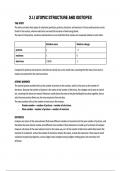2.1.1 atomic structure and isotopes
The atom
The atom contains three types of subatomic particles, protons, electrons and neutrons. Protons and neutrons can be
found in the nucleus, whereas electrons surround the nucleus in fixed energy levels.
The mass of the protons, neutrons and electrons are so small that their masses are measured relative to each other.
Relative mass Relative charge
protons 1 +1
neutrons 1 0
electrons 1/1836 -1
Compared to protons and neutrons, the electron clearly has a very small mass, meaning that the mass of an atom is
mainly concentrated in the central nucleus.
Atomic number
The atomic (proton number) tells us the number of protons in the nucleus, which is the same as the number of
electrons. Because the number of protons is the same as the number of electrons, the charges can be seen to cancel
out, meaning that atoms are neutral. Neutrons could almost be seen as the glue holding the nucleus together, hence
why the more protons there are, the more neutrons there are also.
The mass number tells us the number of neutrons in the nucleus.
- Atomic number = number of protons = number of electrons
- Mass number = number of protons + number of neutrons
Isotopes
Isotopes are atoms of the same element that have different numbers of neutrons but the same number of protons, and
therefore the same atomic number, but different mass numbers. Most elements are made up of a mixture of isotopes.
However, all atoms of the same element react in the same way, as it is the number of electrons which determines the
reaction of an element, and as the number of electrons remains the same, so does the reactivity. There may be small
variations in physical properties, such as larger mass isotopes having a higher melting point, but reactivity isn't
affected.
,History of the atom
1803 - John Dalton
- Atoms are solid spheres
1897 - JJ thompson
- Plum pudding model, atoms are balls of positive charge with
negative electrons embedded in it
1909 - ernest rutherford
- Discovered the nucleus
- He said the nucleus was a very small ball of positive charge and
the electrons surrounded the nucleus in a ‘cloud’, but the atom
was mainly empty space
- Evidence = alpha particle scattering experiment through gold
leaf
1913 - niels bohr
- The clouds in Rutherford’s theory could collapse, so electrons
must be in fixed energy levels
- Evidence = when electromagnetic radiation is absorbed,
electrons move between shells and the emit that radiation when electrons move to lower energy levels,
which can only be explained by the energy shell theory
Present day
- Electrons don't have the same energy in shells, we have sub shells, which explains ionisation trends
Relative mass
Carbon-12 acts as a standard for measuring atomic mass, which is its own unit and is represented by the letter u. This
standard is created because we cannot simply add the relative masses of an atom’s protons, neutrons and electrons as
the strong forces of attraction between protons and neutrons in the nucleus actually cause a slight loss in mass, called
the mass defect.
So, the mass of carbon-12 isotope is exactly 12u (atomic mass units). This means that 1/12th of a carbon atom is one
atomic mass unit. One u is approximately the mass of one proton or a neutron.
Knowing this, we can clearly define the terms relative atomic mass, relative isotopic mass and relative molecular
mass.
- Relative atomic mass (Ar) : the weighted mean mass of an atom of an element compared with 1/12th of the
mass of an atom of carbon-12
- Relative isotopic mass : the mass of an atom of an isotope compared with 1/12th of the mass of an atom of
carbon-12
, - Relative molecular mass (Mr) : the mean mass of a molecule compared with 1/12th of the mass of an atom
of carbon-12
The weighted mean mass of an atom takes into account the percentage abundance of each isotope, as well as the
relative isotopic mass of the isotope.
Mass spectroscopy
The abundance of an isotope can be determined using a mass spectrometer, using the following method:
1. The sample is placed in the mass spectrometer
2. The sample is vaporised and then ionised to form positive ions
3. The ions are accelerated, and because the larger, heavier ions take longer to travel, they take longer to be
deflected, therefore separating the isotopes of an element
4. The ions are detected on a mass spectrum as a mass to charge ratio, and as each ion is deflected, it adds to
the signal of the other ions of the same mass. The mass to charge ratio, usually expressed as m/z is the mass
to charge ratio of an ion, so can simply be found by dividing the mass by the charge. If an ion has a +1 charge,
this is equivalent to the relative isotopic mass.
When you know the abundance of each of the isotopes, you can also workout the relative
atomic mass of an element using this equation:
Relative atomic mass = (abundance A x m/z A) + (abundance B x m/z B)
total abundance
This mass spectrum shows the abundance of chlorine-35 and chlorine-37 ->
<-The relative atomic mass would be 35.5, shown by
this working




